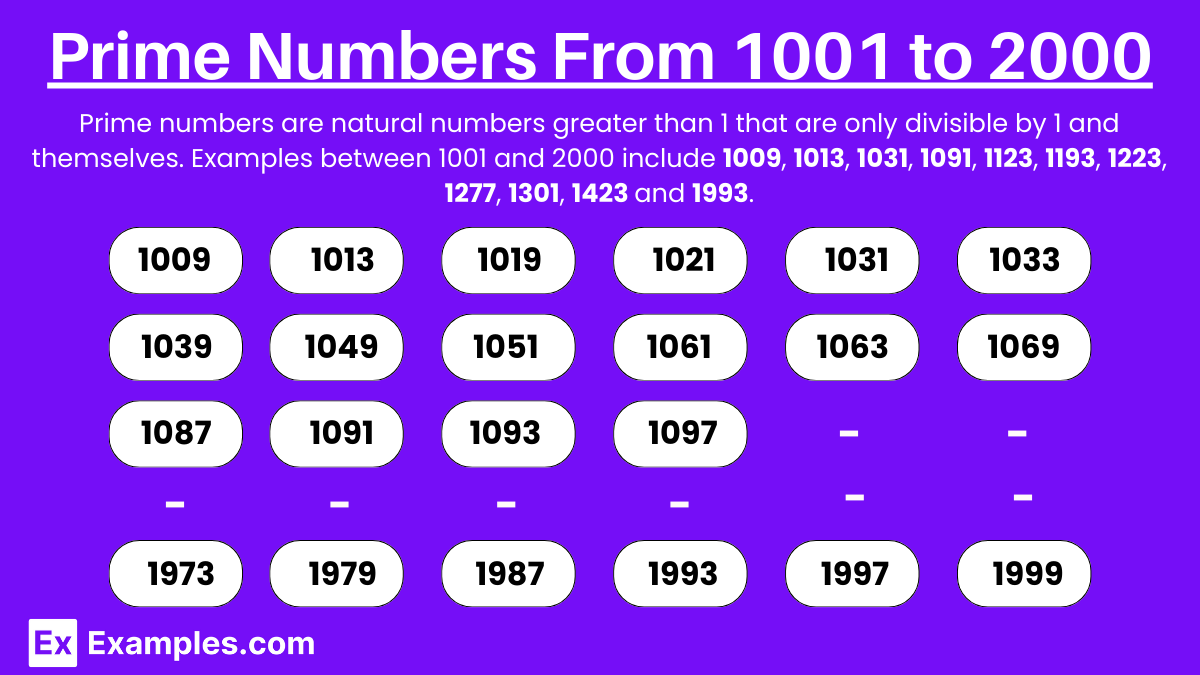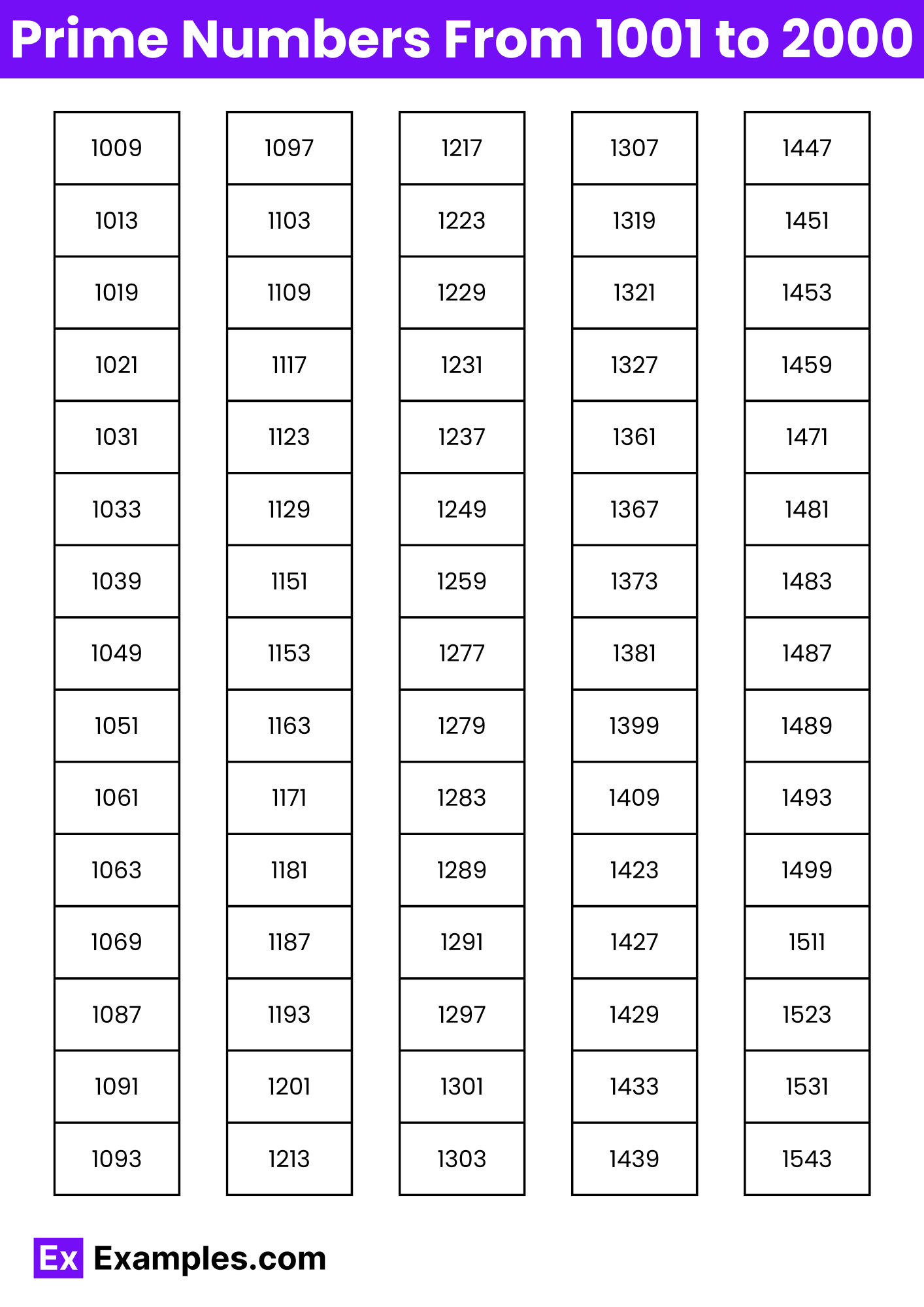Which of the following numbers is a prime number?
1009
1012
1015
1018


Prime numbers between 1001 and 2000 are natural numbers greater than 1 that have no positive divisors other than 1 and themselves, ensuring they cannot be formed by multiplying two smaller natural integers. These primes continue the sequence beyond the initial 1000, contributing to the understanding of prime distribution and properties in higher ranges. Examples in this range include 1009, 1013, 1019, up to 1997, each maintaining the defining characteristic of having exactly two distinct positive divisors. These prime numbers are fundamental in various advanced mathematics applications and theories, distinguishing them from composite numbers, which have additional factors.
Download List of Prime Numbers From 1001 to 2000 in Pdf

Download Prime Numbers From 1001 to 2000 in Pdf
| Prime Numbers | Prime Numbers |
|---|---|
| 1009 | 1511 |
| 1013 | 1523 |
| 1019 | 1531 |
| 1021 | 1543 |
| 1031 | 1549 |
| 1033 | 1553 |
| 1039 | 1559 |
| 1049 | 1567 |
| 1051 | 1571 |
| 1061 | 1579 |
| 1063 | 1583 |
| 1069 | 1597 |
| 1087 | 1607 |
| 1091 | 1609 |
| 1093 | 1613 |
| 1097 | 1619 |
| 1103 | 1621 |
| 1109 | 1627 |
| 1117 | 1637 |
| 1123 | 1657 |
| 1129 | 1663 |
| 1151 | 1667 |
| 1153 | 1669 |
| 1163 | 1693 |
| 1171 | 1697 |
| 1181 | 1699 |
| 1187 | 1709 |
| 1193 | 1721 |
| 1201 | 1723 |
| 1213 | 1733 |
| 1217 | 1741 |
| 1223 | 1747 |
| 1229 | 1753 |
| 1231 | 1759 |
| 1237 | 1777 |
| 1249 | 1783 |
| 1259 | 1787 |
| 1277 | 1789 |
| 1279 | 1801 |
| 1283 | 1811 |
| 1289 | 1823 |
| 1291 | 1831 |
| 1297 | 1847 |
| 1301 | 1861 |
| 1303 | 1867 |
| 1307 | 1871 |
| 1319 | 1873 |
| 1321 | 1877 |
| 1327 | 1879 |
| 1361 | 1889 |
| 1367 | 1901 |
| 1373 | 1907 |
| 1381 | 1913 |
| 1399 | 1931 |
| 1409 | 1933 |
| 1423 | 1949 |
| 1427 | 1951 |
| 1429 | 1973 |
| 1433 | 1979 |
| 1439 | 1987 |
| 1447 | 1993 |
| 1451 | 1997 |
| 1453 | 1999 |
| 1459 | |
| 1471 | |
| 1481 | |
| 1483 | |
| 1487 | |
| 1489 | |
| 1493 | |
| 1499 |
Prime numbers between 1001 and 2000 extend the fascinating sequence of natural numbers that have only two distinct positive divisors, 1 and themselves. These primes, like 1009, 1013, and 1997, play a crucial role in mathematics, particularly in areas such as number theory and cryptography. Their distribution in this range provides deeper insights into the properties and patterns of integers, highlighting the distinction between prime and composite numbers. Understanding these primes enhances our comprehension of algebra and the fundamental structure of numbers, solidifying their importance in advanced mathematical studies.
Text prompt
Add Tone
10 Examples of Public speaking
20 Examples of Gas lighting
Which of the following numbers is a prime number?
1009
1012
1015
1018
Identify the prime number among these:
1021
1023
1026
1029
What is the prime number in this list?
1031
1032
1034
1036
Which of these is not a prime number?
1049
1051
1053
1061
Find the prime number from the following options:
1070
1063
1066
1068
Which number is a prime number?
1087
1090
1091
1093
Select the prime number from the following:
1103
1105
1107
1109
What is the prime number in this set?
1134
1132
1130
1129
Which of these numbers is a prime number?
1151
1153
1155
1158
Identify the prime number from this list:
1181
1182
1184
1185
Before you leave, take our quick quiz to enhance your learning!

